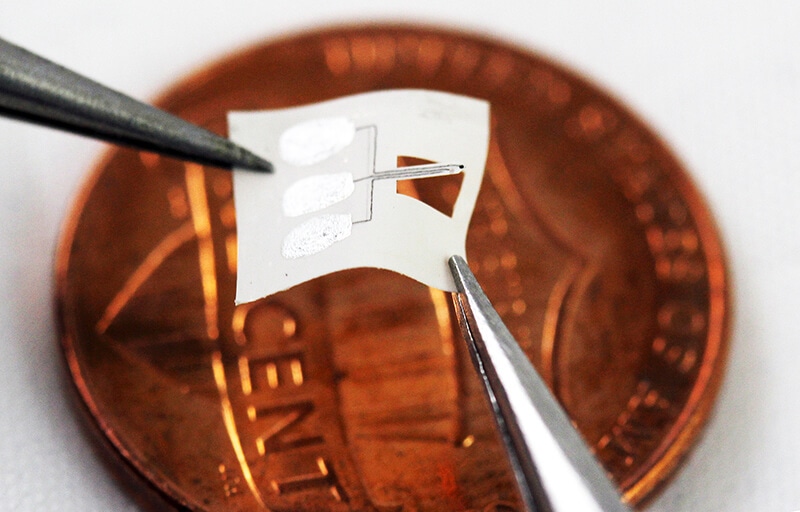Mar 28 2019
Past studies have suggested that the chances of getting a horrible migraine will increase after a spinal cord injury, thanks to a chemical messenger present in the brain that spikes to toxic levels.
 An implantable sensor has the speed and precision for tracking a brain chemical known to be elevated in certain brain diseases and after a spinal cord injury. (Image credit: Purdue University image/Tran Nguyen)
An implantable sensor has the speed and precision for tracking a brain chemical known to be elevated in certain brain diseases and after a spinal cord injury. (Image credit: Purdue University image/Tran Nguyen)
To bring about better treatment, researchers will have to catch that split-second spike in action and carefully track its path of destruction.
Engineers from Purdue University have developed a small, flexible sensor that is faster and more accurate in comparison to the earlier attempts at tracking this chemical known as glutamate. As an implantable device on the spinal cord, this sensor is mainly a research tool used for testing in animal models; however, it could find future clinical use as a method to observe whether a drug for brain disease or neurotrauma is working.
This research will be published in the upcoming issue of Biosensors and Bioelectronics.
When you feel like you’re running a fever, it doesn’t matter when you check your temperature—it will probably be the same for several hours. But a glutamate spike is so fast that if you don’t capture it at that moment, you miss the whole opportunity to get data.
Riyi Shi, Professor of Neuroscience and Biomedical Engineering, Department of Basic Medical Sciences, College of Veterinary Medicine and Weldon School of Biomedical .Engineering, Purdue University
An impact caused by a tackle in football or car accident can injure the spinal cord and also the nerve structures that transmit glutamate, which sends signals to stimulate nerve tissue for executing functions such as memorizing and learning.
Damaged nerve structures highlight that huge volumes of glutamate get leaked into spaces outside of cells, over-exciting and destroying them. Higher levels of glutamate are also shown by brain diseases, including Parkinson’s and Alzheimer’s.
Until now, devices have either lacked adequate sensitivity to detect glutamate, or they were not fast enough to capture its spike nor reasonable enough for long-term research projects.
These issues are being addressed by Purdue researchers via implantable sensors that they have 3D printed and laser-micromachined—processes that are already employed regularly in the industry and lab.
We wanted to create a low-cost and very fast way to build these sensors so that we can easily provide researchers with a means to measure glutamate levels in vivo.
Hugh Lee, Assistant Professor of Biomedical Engineering, Purdue University.
Lee concentrates on implantable microtechnologies.
The technique permits researchers to quickly change the shape, size, and orientation of the sensors and then test in animal models without the need for going through the extremely expensive process of microfabrication.
Measuring levels in vivo will also help researchers to study how spinal cord injuries occur, and also how brain diseases develop.
How big of a problem is a migraine? Is too much glutamate really behind the pain, or is it that the system that cleans up glutamate is down?
Riyi Shi, Professor of Neuroscience and Biomedical Engineering, Department of Basic Medical Sciences, College of Veterinary Medicine and Weldon School of Biomedical Engineering, Purdue University.
The device was implanted into the spinal cord of an animal model and the cord was then injured in order to observe a spike. The spike was instantly captured by the device, while for existing devices, researchers had to wait 30 minutes to obtain data after causing damage to the spinal cord.
Going forward, the researchers plan to come up with a way that will allow the biosensors to self-clear of inflammatory cells that the body recruits to shield itself. These cells usually produce a fibrous capsule around the biosensor, which blocks its sensitivity.
This technology could also permit the implantation of more sensors along the spinal cord, which indeed would help researchers to understand how far glutamate spreads and also the speed at which this takes place.
A patent application for this device has been filed by the researchers with the Purdue Research Foundation Office of Technology Commercialization. The work received support from the Global Research Outreach program of the Samsung Advanced Institute of Technology, the National Institutes of Health, and sponsored in part by the National Science Foundation under grant CNS-1726865.
This study aligns with Purdue’s Giant Leaps celebration, recognizing the university’s global developments made in longevity, health, and quality of life as part of Purdue’s 150th anniversary. This is one of the four themes of the yearlong celebration’s Ideas Festival, intended to showcase Purdue as a knowledgeable center resolving real-world problems.
Glutamate Sensor for Spinal Cord Injuries
(Video credit: Purdue University)